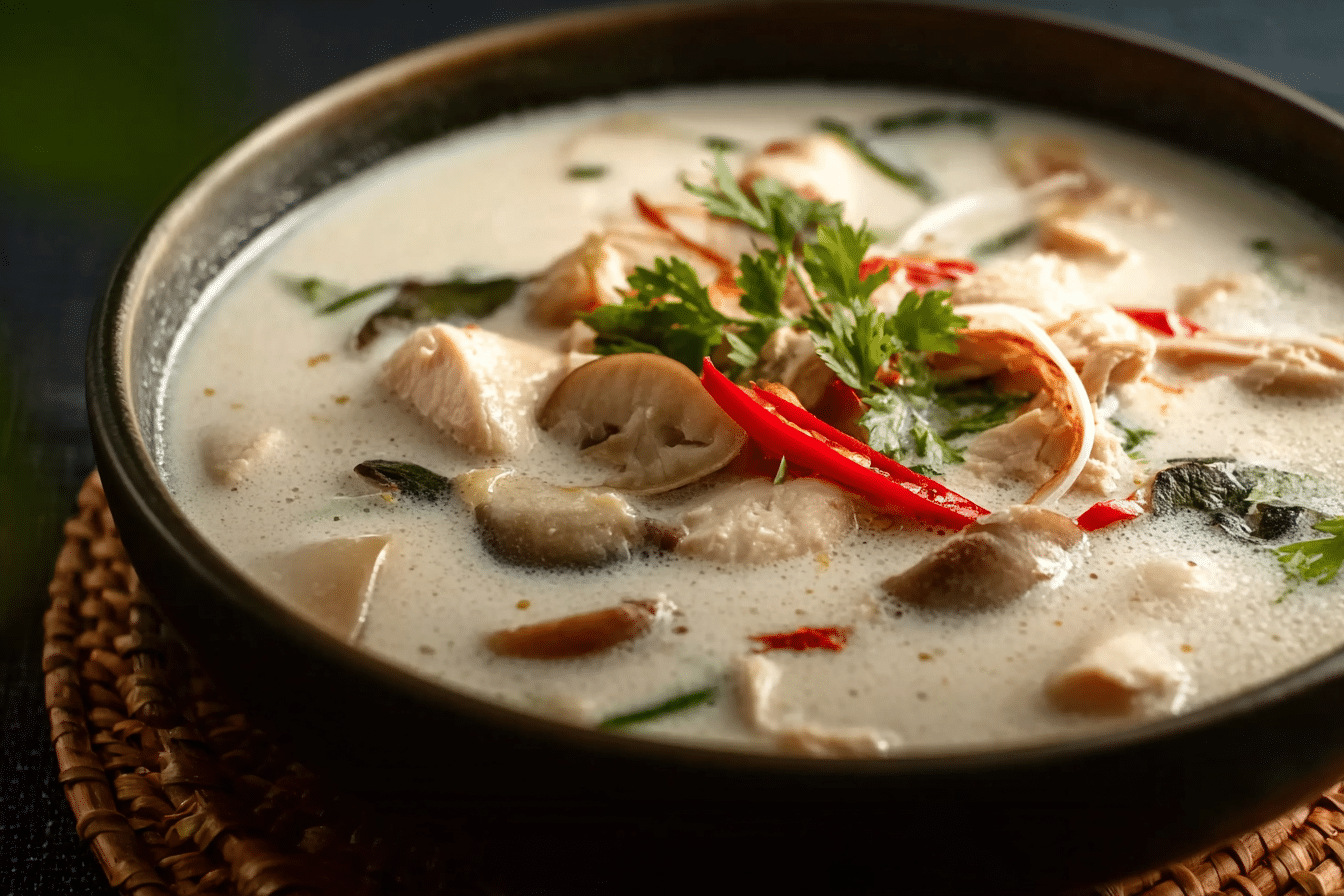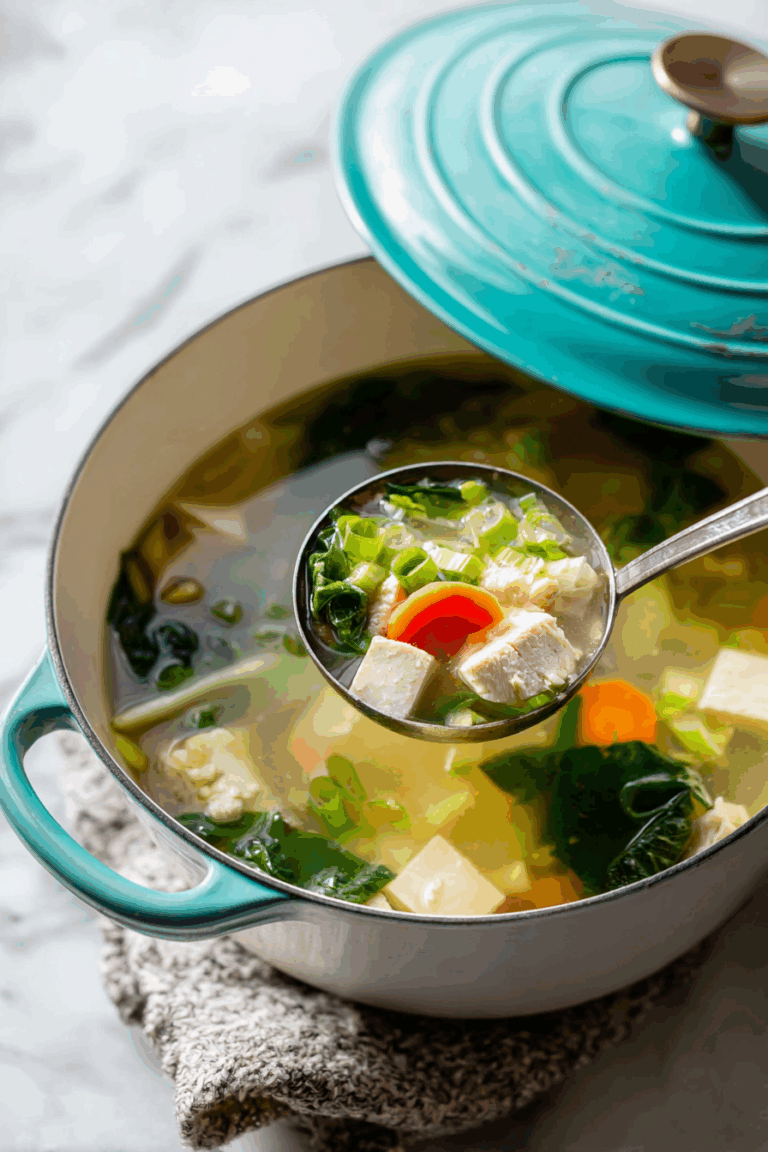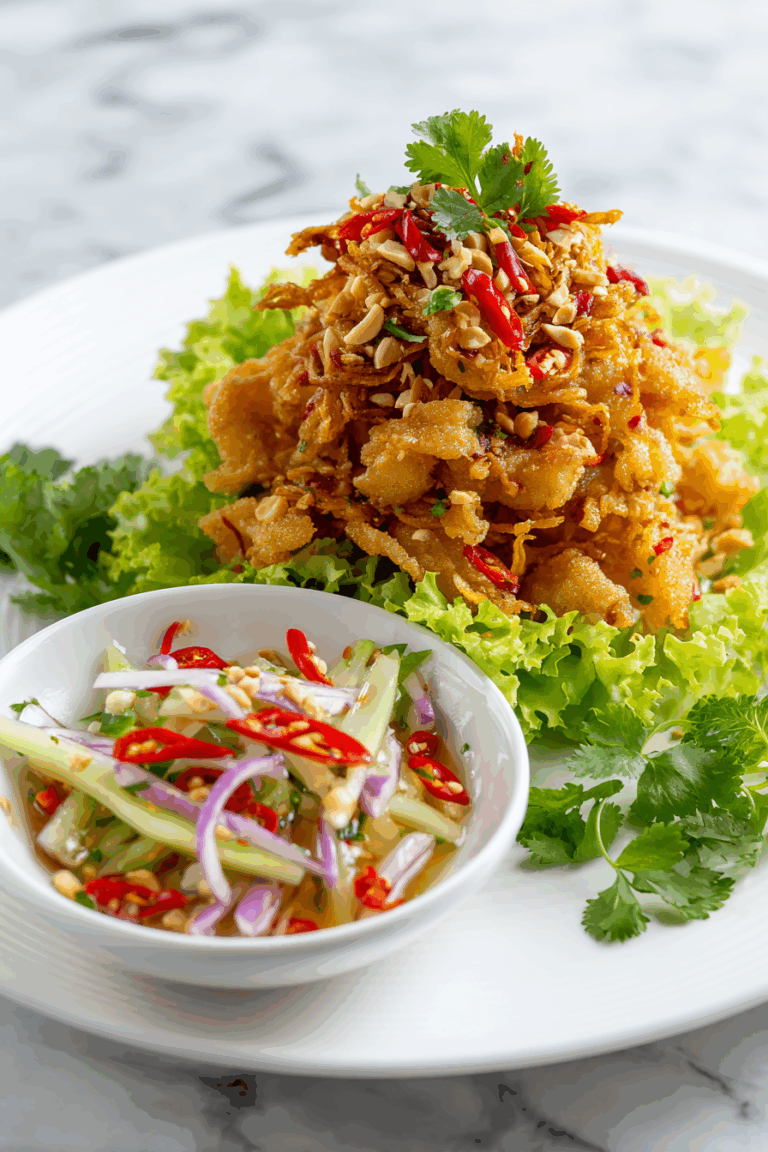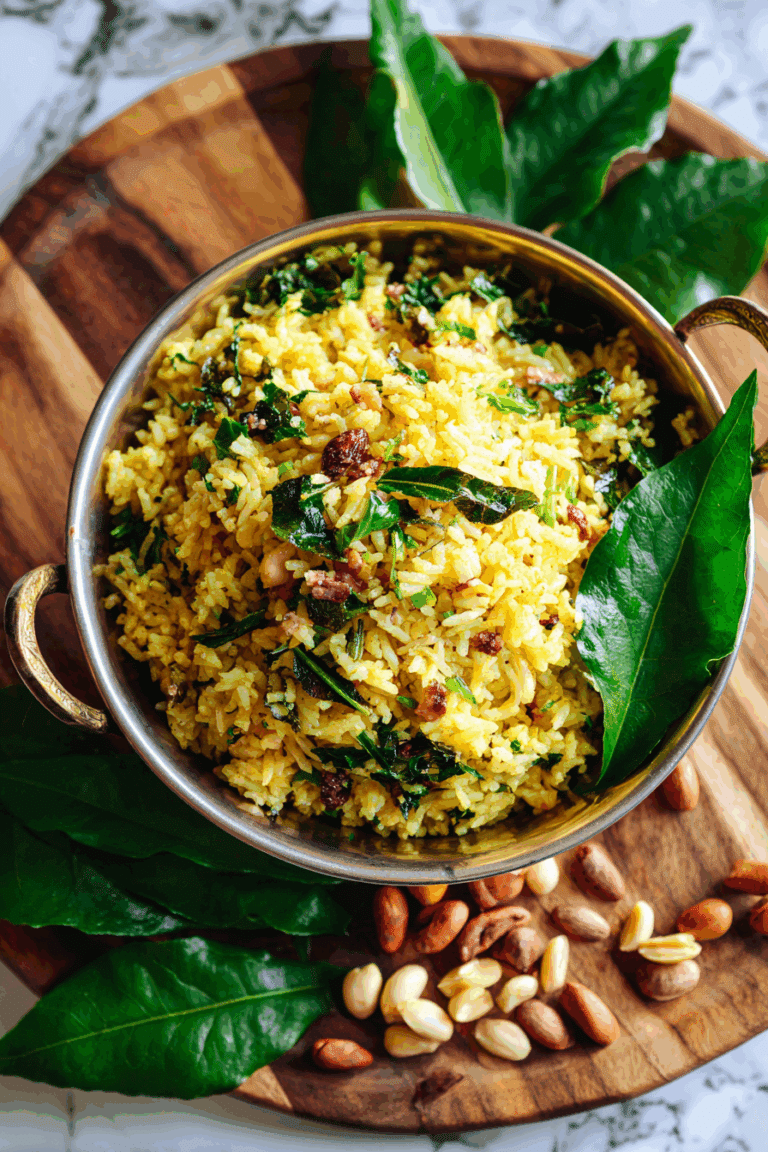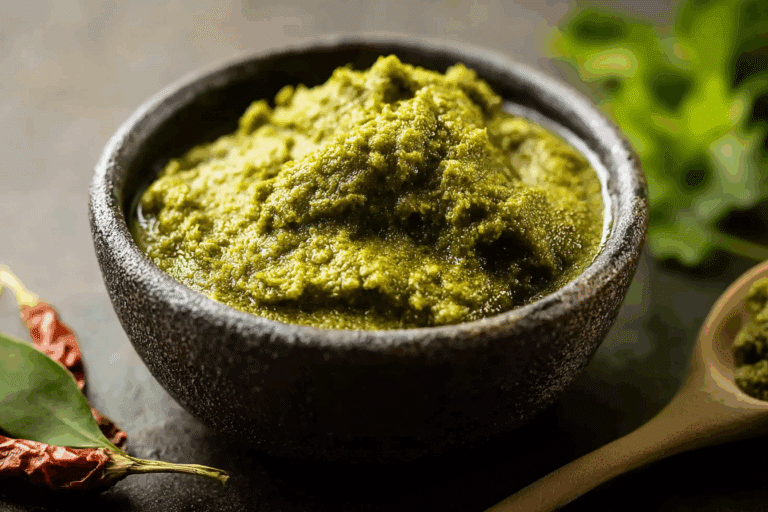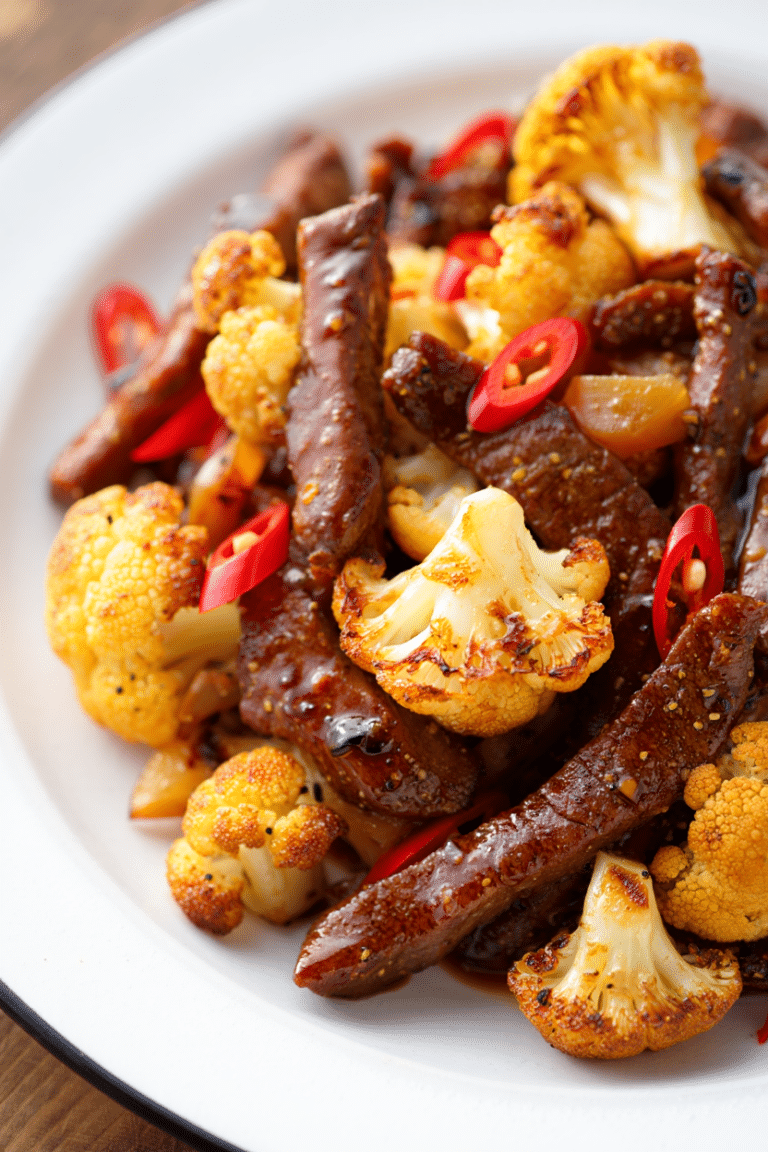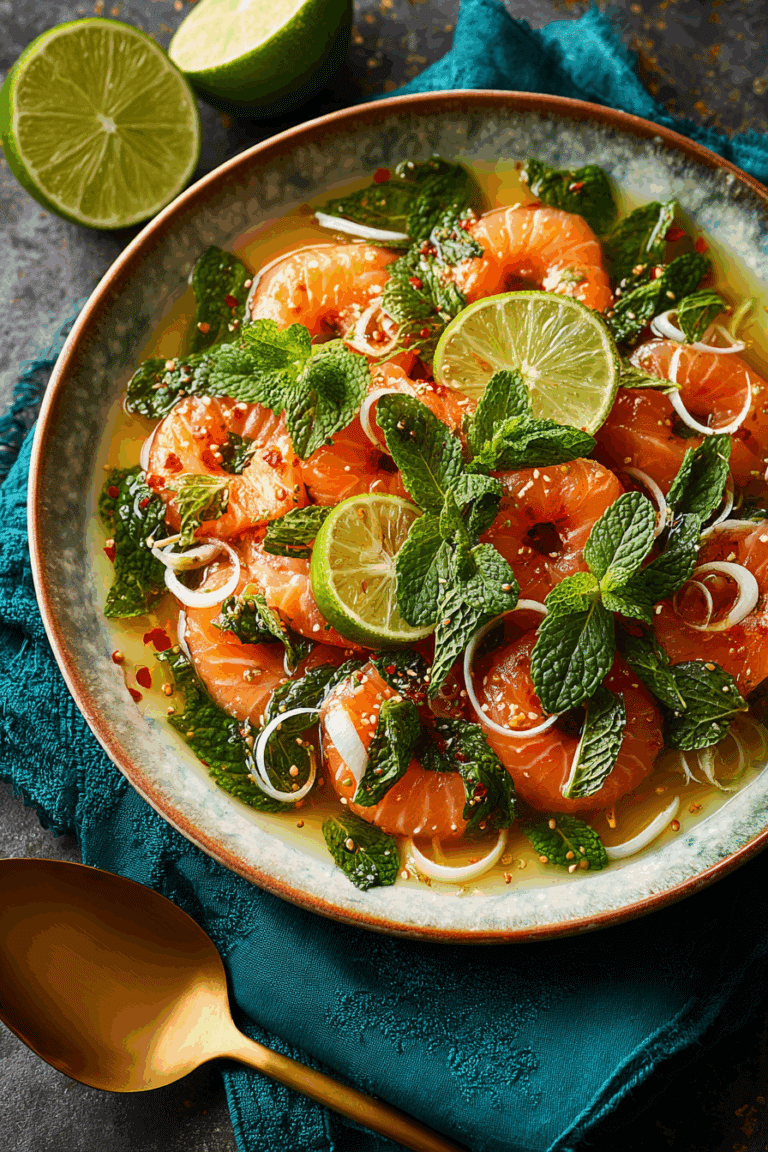Coconut Galangal Chicken Soup Recipe You’ll Love Forever
Coconut Galangal Chicken Soup has a comforting aroma that reminds me of my first trip to Thailand. The steam carried a mix of coconut, lemongrass, and galangal that felt like a warm hug. This soup, known in Thai as Tom Kha Gai, became the dish that made me start Just Thai Recipes, a space where I could share stories and flavors that go beyond the ordinary restaurant menu.
When I began cooking at home, I wanted people to taste how balanced Thai food really is, how it can be soothing and bright at the same time. That idea grew into this blog. Here, every bowl has a story, and Coconut Galangal Chicken Soup is the one that always brings me back to why I love cooking.
In this article, you will learn how to prepare a deeply flavored Coconut Galangal Chicken Soup, what ingredients make it authentic, and the simple tricks that help you keep that silky coconut base from curdling. You will also find background details about Thai culinary traditions and ways to adapt this recipe to your own kitchen.
Table of Contents
Table of Contents
Ingredients for Coconut Galangal Chicken Soup
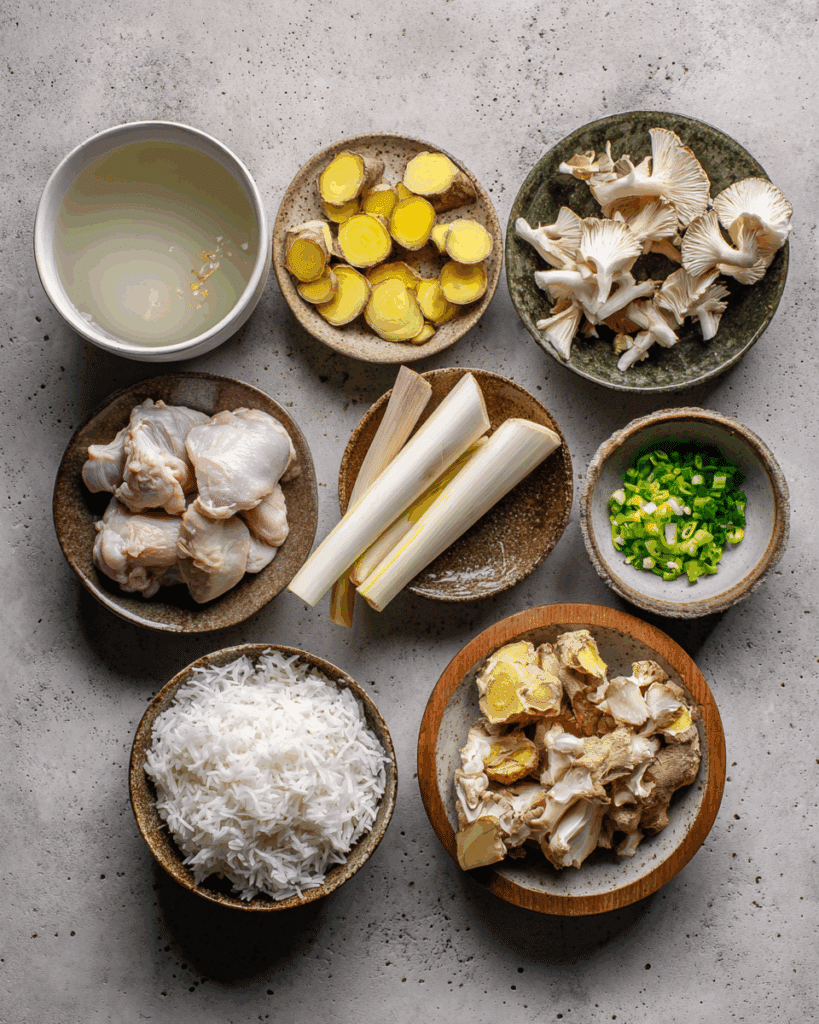
The heart of Coconut Galangal Chicken Soup lies in its aromatic blend. Every ingredient adds a different layer, and together they form the famous balance of Thai cuisine. For the most authentic taste, try to source the freshest herbs possible.
You will need:
- 2 cups chicken stock, unsalted and preferably homemade. Fresh stock gives the soup depth, while store-bought versions can make it too salty.
- 1 ½ cups coconut milk, full-fat if possible, since it creates that creamy mouthfeel that defines Coconut Galangal Chicken Soup.
- ½ teaspoon table salt to season the broth gently.
- 1 pound chicken thigh, boneless and skinless, cut into one-inch pieces so they cook evenly.
- 1 stalk lemongrass, the bottom half only, smashed lightly and sliced into two-inch pieces to release citrusy oils.
- 12 thin slices of galangal, a root that looks like ginger but carries a sharp pine and citrus scent. This is the ingredient that gives Coconut Galangal Chicken Soup its name and unmistakable aroma.
- 5 makrut lime leaves, twisted and torn to bruise them, which lets the oils perfume the broth.
- 1 to 3 Thai chilies, smashed or sliced, depending on how spicy you like your Coconut Galangal Chicken Soup.
- 2 tablespoons fish sauce, which adds umami and a salty depth that balances the coconut sweetness.
- 1 teaspoon finely chopped palm sugar or regular sugar for a hint of sweetness.
- 5.5 ounces oyster mushrooms, torn into bite-size pieces, giving the soup an earthy softness.
- 2 ½ tablespoons lime juice, fresh-squeezed, which brightens the entire dish right before serving.
- Chopped green onion and cilantro for garnish.
- Jasmine rice for serving, optional but traditional.
If you need substitutes, ginger can replace galangal when it is unavailable, though the flavor will be milder. For those who cannot find makrut lime leaves, use a small strip of lime zest, which still contributes that citrus lift.
The coconut milk you choose matters. Some brands separate easily when heated, so stir the can well before measuring. Look for unsweetened coconut milk, not coconut cream, to keep the flavor light.
Homemade chicken stock gives the soup a deeper background flavor. Simmer bones, garlic, onion, and a bit of ginger for about two hours to build a stock that pairs beautifully with the herbs in Coconut Galangal Chicken Soup.
Step-by-Step Instructions
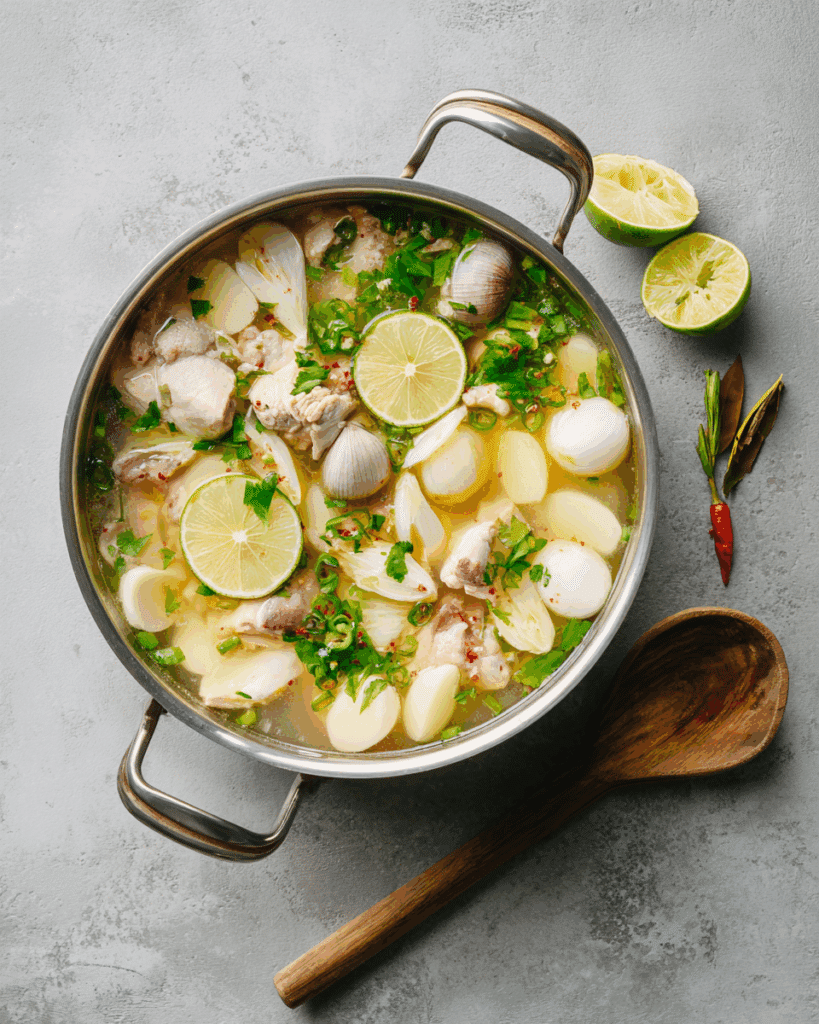
Cooking Coconut Galangal Chicken Soup is surprisingly simple once the ingredients are prepared. The key is to control the heat so the coconut milk stays smooth and the aromatics release their fragrance without turning bitter.
- Prepare the broth. Bring two cups of chicken stock to a gentle boil in a medium pot. Add the salt and chicken thigh pieces. Simmer them for about fifteen minutes until the chicken becomes tender enough to shred slightly with a fork. This stage infuses the broth with chicken flavor, which forms the base of your Coconut Galangal Chicken Soup.
- Add the aromatics and coconut milk. Pour in the coconut milk, then add lemongrass, galangal slices, makrut lime leaves, Thai chilies, mushrooms, half of the fish sauce, and the sugar. Stir gently, and lower the heat to maintain a light simmer for about five minutes. This allows the herbs to infuse without boiling the coconut milk. When you smell the perfume of lemongrass and galangal, you know your Coconut Galangal Chicken Soup is developing its character.
- Adjust seasoning. Taste the soup. If it needs more saltiness, add a bit more fish sauce. Remember that the lime juice you add later will balance out the salt and spice.
- Finish with freshness. Turn off the heat and stir in two tablespoons of lime juice. Taste again, then add more lime if you prefer a sharper tang. Top with chopped green onions and cilantro for color and a burst of fresh aroma.
- Serve and enjoy. Traditionally, Coconut Galangal Chicken Soup is served alongside jasmine rice, which soaks up the flavorful broth. You can enjoy it as a starter or as a light meal by itself.
For a visual step-by-step version, you can find inspiration from 40 Aprons and Hot Thai Kitchen, both of which share wonderful interpretations of Tom Kha Gai. Their guides explain how small details, such as when to add the lime juice, can make a difference in keeping your Coconut Galangal Chicken Soup creamy and balanced.
Cooking tip: never let the soup boil vigorously after adding the coconut milk, because high heat can cause it to separate. A slow simmer keeps the texture silky and the color white. Also, remove lemongrass, galangal slices, and lime leaves before serving or simply remind guests not to eat them, as they are for aroma only.
Another little secret I learned through practice is to taste at every step. Thai cooking is all about adjusting on the go. Sometimes one lime is juicier, or one chili is hotter. This is why no two bowls of Coconut Galangal Chicken Soup ever taste exactly the same, yet each bowl feels comforting and personal.
Tips and Tricks for Perfect Coconut Galangal Chicken Soup
Coconut Galangal Chicken Soup is a dish that rewards attention to detail. The flavors depend on balance and timing, not on complicated techniques. Over the years, I’ve learned a few small habits that make every pot of Coconut Galangal Chicken Soup come out fragrant, creamy, and perfectly seasoned.
The first trick is to treat your coconut milk with care. When you pour it into the pot, lower the heat right away. Coconut milk curdles if it boils too long or too hard. Keep it at a gentle simmer, which allows the fat to stay smooth. Stir softly with a wooden spoon now and then. This keeps the texture silky and prevents the bottom from scorching.
Another key tip for Coconut Galangal Chicken Soup is how you handle the aromatics. Galangal, lemongrass, and makrut lime leaves all release their essential oils when bruised slightly. Take the back of a knife and press on the lemongrass before slicing it. Twist the lime leaves gently to open their natural oils. Slice the galangal thin enough so its aroma infuses without overpowering. These small steps build that signature fragrance people associate with Coconut Galangal Chicken Soup.
The next trick is to balance saltiness, sourness, and sweetness. Thai food always plays with these three flavors. After simmering your Coconut Galangal Chicken Soup, taste it before serving. Add more fish sauce if it feels flat, a drop of lime juice if it tastes heavy, or a pinch of sugar if the chilies are too sharp. Every ingredient should feel like it belongs.
When reheating leftovers, warm the Coconut Galangal Chicken Soup over very low heat. Coconut milk thickens as it cools, so you can add a spoonful of water or stock to bring back the smooth texture. Avoid microwaving it directly at high heat, as that often causes separation.
Lastly, always serve Coconut Galangal Chicken Soup fresh. The herbs fade with time, and the brightness of lime juice dulls after a few hours. If you plan to make it ahead, cook the chicken and broth first, then add the coconut milk and herbs just before serving. This keeps the flavor alive and authentic.
These simple habits turn an ordinary bowl into something unforgettable. Once you practice them, making Coconut Galangal Chicken Soup becomes second nature. Every time you simmer the pot, your kitchen fills with warmth, and your guests always ask for seconds.
Variations of Coconut Galangal Chicken Soup
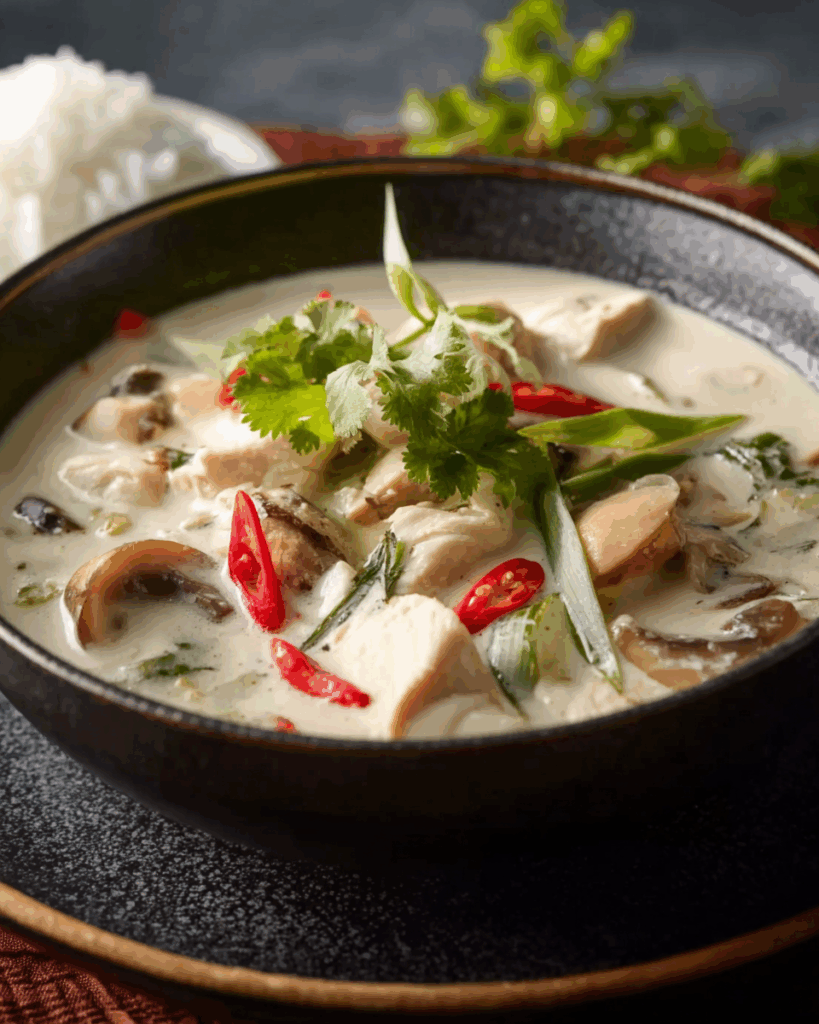
One of the best things about Coconut Galangal Chicken Soup is its flexibility. You can adjust the ingredients to suit your mood, diet, or what you have in the fridge. Here are a few creative ways to play with the recipe while keeping that comforting Thai essence intact.
1. Seafood Coconut Galangal Soup
Replace the chicken with shrimp, scallops, or chunks of white fish. The seafood absorbs the coconut broth beautifully and adds a gentle sweetness. This variation of Coconut Galangal Chicken Soup works well for a lighter dinner, especially when paired with jasmine rice and a squeeze of extra lime juice.
2. Vegetarian Coconut Galangal Soup
For a meat-free version, swap chicken stock for vegetable broth and use tofu cubes instead of chicken. You can increase the mushrooms for more body and umami. Coconut Galangal Chicken Soup in this form still tastes authentic, as the galangal, lime leaves, and lemongrass carry most of the traditional flavor.
3. Creamy Coconut Galangal Chicken Soup with Extra Coconut Milk
If you enjoy a richer texture, increase the coconut milk by half a cup. The extra creaminess makes the soup thicker, almost stew-like. This style of Coconut Galangal Chicken Soup feels indulgent and is perfect for cold evenings.
4. Spicy Coconut Galangal Chicken Soup
Some people love the soup with extra heat. Add more Thai chilies or a spoonful of chili paste while simmering. The spicy steam that rises from the pot is irresistible, and it pairs perfectly with cool sides like cucumber salad or fresh herbs.
5. Easy Tom Kha Soup Recipe Version
If you are short on time, make a simplified version using store-bought chicken broth and pre-sliced galangal or lemongrass paste. It may not have the exact depth of flavor, but this easy Coconut Galangal Chicken Soup still delivers that familiar balance of creamy, sour, and savory notes that everyone loves.
Whichever version you try, remember that Coconut Galangal Chicken Soup is about comfort. Thai families cook it in many forms, depending on what’s in the pantry. What stays constant is that heartwarming balance of coconut richness and citrusy galangal aroma.
Another fun twist is to experiment with toppings. Sprinkle toasted coconut flakes for a bit of crunch, or drizzle a few drops of chili oil for color and heat. You can even add a handful of spinach or baby kale near the end for extra nutrition. Each variation proves that Coconut Galangal Chicken Soup is endlessly adaptable while staying true to its Thai roots.
Nutrition and Health Benefits of Coconut Galangal Chicken Soup
Coconut Galangal Chicken Soup is more than just a delicious meal. It’s a nourishing bowl full of natural ingredients that support your body while satisfying your taste buds. The combination of protein, healthy fats, and healing herbs makes this soup both comforting and wholesome.
A typical serving of Coconut Galangal Chicken Soup contains around 300 to 350 calories, depending on how much coconut milk you use. Most of the calories come from the coconut milk, which provides medium-chain fatty acids. These fats are easier to digest and may give your body quick energy. Coconut also adds a creamy texture without the need for dairy, making Coconut Galangal Chicken Soup suitable for lactose-intolerant eaters.
The chicken contributes lean protein that helps build and repair muscles. Using thigh meat keeps it juicy and tender, so your Coconut Galangal Chicken Soup stays rich without drying out.
Galangal itself is a powerful root often used in traditional medicine. It belongs to the same family as ginger but has stronger anti-inflammatory properties. Some studies suggest galangal supports digestion and boosts circulation, which makes a bowl of Coconut Galangal Chicken Soup both soothing and restorative.
Lemongrass and lime leaves bring antioxidants and natural oils that promote detoxification. They also provide the bright, clean flavor that balances the richness of coconut milk. Thai people often drink lemongrass tea for stomach relief, which explains why Coconut Galangal Chicken Soup feels gentle when you’re under the weather.
Chilies, used in moderation, add a dose of vitamin C and can help clear sinuses. If you prefer milder heat, remove the seeds but still include the skins, since they contribute aroma without overwhelming spice.
Fish sauce, though salty, contains amino acids that enhance flavor while offering trace minerals. Palm sugar adds a natural sweetness that complements all the sour and salty notes, preventing the dish from tasting one-dimensional.
Eating Coconut Galangal Chicken Soup regularly can help you maintain balanced nutrition. It provides hydration through broth, energy from coconut fat, and immune support from herbs. When paired with jasmine rice, it becomes a complete meal with carbohydrates, protein, and healthy fat all in one bowl.
The beauty of Coconut Galangal Chicken Soup lies in its simplicity. Every spoonful feels nourishing, the kind of comfort food that supports your health without feeling heavy. When made with care, it becomes a reminder that food can be both medicine and joy.
Make-Ahead, Storage, and Freezing
A great Thai soup like this one fits easily into a busy lifestyle. You can prepare parts of it ahead of time and enjoy it throughout the week without losing flavor. The key is to understand how each ingredient behaves when stored.
If you want to prepare the broth early, simmer the stock with chicken pieces first, then strain it to remove any bits. Keep this clear base in the refrigerator for up to three days. When you are ready to serve, add the herbs, coconut milk, and lime juice fresh. Doing this keeps the aroma lively and prevents the broth from turning dull.
When refrigerating leftovers, always let the soup cool completely before transferring it to a sealed container. A glass jar or BPA-free plastic container with a tight lid works best. It will stay good in the refrigerator for about two days. Beyond that, the delicate flavors of lemongrass and lime begin to fade, and the creamy texture might separate slightly.
If you plan to freeze the soup, divide it into single portions. Avoid adding the lime juice before freezing, since acid can change the flavor over time. Instead, stir it in after reheating. Frozen soup can last up to two months and will still taste satisfying once thawed and reheated gently.
When reheating, never rush the process. Warm it over low heat while stirring slowly. If it seems too thick, a splash of stock or water brings back its smooth texture. Microwave reheating can work too, but use short bursts and stir between each one to prevent separation.
For meal prep, store cooked rice separately in another container. Keeping rice apart prevents it from soaking up too much broth. When serving, spoon rice into a bowl first, then ladle the hot soup over it. This simple step gives the perfect balance of creamy and fluffy textures.
Making this dish ahead of time lets the flavors meld, and each reheated bowl still carries that fragrant, soothing aroma that Thai soups are known for. Whether you’re prepping for a family dinner or saving portions for work lunches, these storage habits keep every serving as delicious as the first one.
Common Mistakes to Avoid
Even experienced cooks sometimes struggle with getting this soup just right. Thai cooking relies heavily on timing and balance, and a few small errors can change the result. Knowing what to avoid will help you master it more quickly.
The first common mistake is boiling the coconut milk too hard. High heat makes the fat separate from the liquid, leaving an oily surface instead of a creamy base. Keep the heat low and steady after adding the coconut milk. The gentle simmer keeps everything smooth.
The second mistake is using dried or old galangal and lemongrass. These herbs lose their vibrant oils over time, which dulls the overall aroma. Always choose fresh, firm roots and stalks. If you can’t find them, frozen versions are a better option than dried ones.
Another issue happens when cooks add lime juice too early. Acid reacts with coconut milk, causing it to curdle. Always stir in lime juice after turning off the heat, right before serving. This keeps the broth velvety and balanced.
Too much fish sauce can also overpower the subtle sweetness of the broth. Start with a small amount, taste, and adjust gradually. The goal is balance, not saltiness. Thai food is about harmony, and every spoonful should have a mix of salty, sour, and slightly sweet flavors.
Using the wrong mushrooms can affect both texture and flavor. Oyster mushrooms are traditional because they absorb the broth without becoming chewy. Other varieties like button mushrooms can work, but they won’t soak up the delicate aromatics in the same way.
Finally, don’t forget to remove the lemongrass stalks, galangal slices, and lime leaves before serving. These herbs are meant for infusion, not for eating. Leaving them in can confuse guests unfamiliar with Thai food, as their textures are tough and fibrous.
Learning to avoid these common errors ensures your soup remains silky, aromatic, and balanced every single time. It’s a simple dish once you understand these small but important details.
Cultural and Historical Background
Thai cuisine is deeply connected to its geography and culture. The country’s long coastline, tropical climate, and rich soil have shaped the ingredients used for centuries. The soup known as Tom Kha Gai comes from central Thailand, where coconut trees and fragrant herbs grow abundantly. It is a dish that represents the heart of Thai comfort food rich, aromatic, and balanced in every bite.
Historically, this type of coconut-based soup evolved from older recipes that used herbs and roots for medicinal purposes. Galangal, lemongrass, and lime leaves were prized for their healing properties long before they became common in kitchens. Over time, cooks began blending these herbs with coconut milk and chicken, creating a nourishing dish that was both healing and delicious.
In traditional Thai households, the soup is often served alongside other dishes rather than as a single main meal. Thai dining focuses on variety and balance. Meals are shared, and each dish brings a different sensation spicy, sour, salty, or sweet. This soup adds warmth and calmness to the table, balancing spicy curries or tangy salads.
The preparation of this dish also reflects Thai philosophy about harmony in life. Cooking it requires patience, observation, and an understanding of how ingredients behave together. The cook must taste, adjust, and feel their way through the process, much like meditation through food.
In Thailand, local variations appear across regions. In the north, cooks might use fewer chilies and more herbs for a lighter profile. In the south, where people enjoy bolder spice, the soup can become hotter and more intense. Street vendors often serve it in small bowls with rice, while family gatherings feature it in larger pots for sharing.
Beyond Thailand, the dish gained popularity across the world as Thai restaurants spread globally in the late twentieth century. Travelers brought home memories of its fragrance, and soon it became one of the most recognized Thai soups internationally.
This dish is now seen not only as a traditional comfort food but also as a symbol of Thai culinary identity. It bridges generations, connects home cooks with professional chefs, and invites people everywhere to explore Thai flavors in a gentle, approachable way.
Serving Suggestions
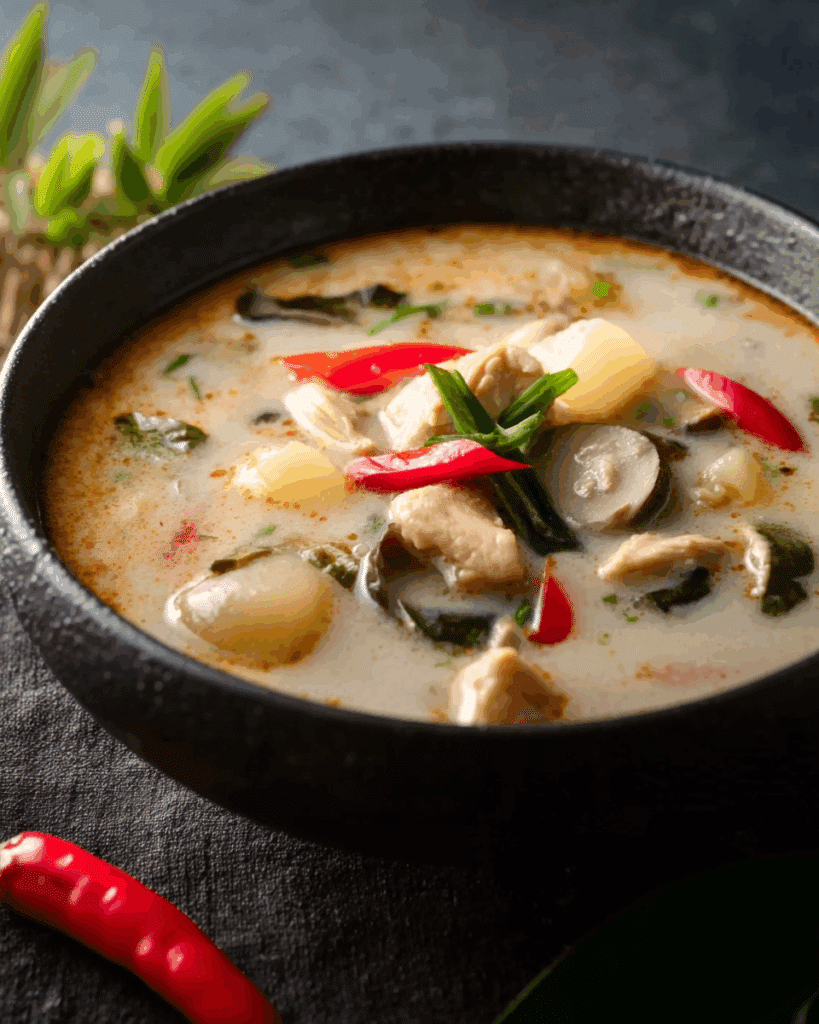
A bowl of this Thai soup is satisfying by itself, yet it becomes even more enjoyable when you think about how to serve it. The way you plate and pair it can completely change the dining experience. Thai cooking often celebrates the balance of textures, colors, and aromas, so the goal is not only to fill the stomach but also to create harmony on the table.
Start by choosing the right bowl. A deep ceramic bowl keeps the heat longer and allows the coconut broth to stay warm until the very last sip. If you serve it for guests, warm the bowls slightly in the oven or fill them with hot water for a minute, then pour the soup in. The gentle heat helps release the aroma of lemongrass and galangal as soon as the bowl reaches the table.
For a simple home meal, serve it with a side of jasmine rice. The rice acts like a sponge, absorbing the creamy broth while softening the spice. In many Thai homes, people spoon a bit of rice into the soup, then eat it together. Others prefer alternating between a spoonful of soup and a bite of rice. There is no strict rule, only preference.
If you want to serve a full Thai-style dinner, pair this soup with lighter dishes that contrast in flavor. A crisp papaya salad brings freshness and crunch. A small plate of stir-fried vegetables or Thai basil chicken adds savory depth. Together they create a well-rounded meal where every bite feels balanced.
For drink pairings, light herbal teas or sparkling water with lime work beautifully. The mild carbonation helps cleanse the palate between spoonfuls. Some people enjoy a chilled Riesling or Sauvignon Blanc, both wines that echo the citrus notes from lemongrass and lime.
Garnishing is another chance to make the presentation shine. Sprinkle chopped cilantro or green onions for a burst of color. If you enjoy a bit of heat, drizzle a few drops of chili oil on top. Toasted coconut flakes or thin slices of red chili can also add contrast without overwhelming the broth.
For a family dinner, place the soup pot directly in the center of the table with a ladle so everyone can serve themselves. This is how Thai families often eat. It encourages sharing, laughter, and conversation. Food is meant to be communal, and soup, being warm and comforting, invites everyone to slow down and connect.
When serving it to guests unfamiliar with Thai cuisine, it helps to mention that the herbs like lemongrass and galangal slices are not eaten. They are for flavoring only. Many first-time diners appreciate this guidance and can relax, enjoying the fragrance without wondering if they should chew those tough pieces.
To turn it into a light lunch, serve smaller portions alongside a salad of shredded cabbage, carrots, and a drizzle of lime-fish sauce dressing. For dinner, offer larger bowls with rice and perhaps a side of fried spring rolls or grilled shrimp skewers. The creamy broth balances fried foods perfectly.
If you like modern presentations, try serving the soup in small cups as an appetizer for a dinner party. The aroma rising from each cup instantly awakens the appetite. Another fun idea is to serve it in coconut shells. The natural scent of the shell subtly enhances the coconut flavor in the broth and makes for a beautiful tropical look.
In Thailand, people often eat this dish as part of a larger shared meal rather than as a first course. The concept of multiple plates allows diners to experience every flavor family spicy, sweet, salty, and sour at once. When planning a Thai-themed evening at home, consider placing several small dishes around the main soup. A mild curry, a grilled meat plate, and a few fresh vegetables or herbs complete the spread.
Texture is just as important as flavor. You can add a bit of crunch by topping the soup with fried shallots or thin strips of crispy wonton. The contrast between creamy broth and crisp topping makes each bite more interesting. If you prefer a healthier twist, sprinkle roasted peanuts or sesame seeds for a nutty finish.
Lighting also affects how food feels. Dim lights and a few candles emphasize the warmth of the soup, while bright natural light highlights its white, milky appearance. Even these small details change how comforting the meal feels.
Finally, remember that this dish is best enjoyed slowly. The aroma shifts as it cools, and the flavors become rounder and gentler. In Thailand, people rarely rush through meals like this one. They savor it, share stories, and appreciate the peaceful rhythm that comes with each spoonful.
Conclusion
Every time I make Coconut Galangal Chicken Soup, I’m reminded of how food can connect people, places, and memories. The first spoonful brings a rush of warmth the coconut’s creaminess, the bright kick of lime, the subtle heat of chilies, and the earthy perfume of galangal. Together, they tell a story of Thailand, where food is not just about eating but about sharing moments and emotions.
This soup has a way of making an ordinary evening feel special. It doesn’t take long to prepare, but it feels like a small celebration in a bowl. Whether you’re cooking for family, impressing guests, or simply craving comfort, Coconut Galangal Chicken Soup delivers that perfect mix of flavor and calm.
If you try this recipe, don’t rush the process. Let the herbs release their fragrance slowly, taste as you go, and enjoy how the broth evolves from simple stock to something magical. That quiet transformation is what makes cooking this soup such a joy.
And when you sit down to eat, take a moment to breathe in the aroma before you take that first spoonful. You’ll understand why this dish has become one of the most loved soups around the world. It’s creamy yet refreshing, spicy yet soothing, and deeply satisfying in a way that few dishes manage to be.
So grab a pot, gather your ingredients, and start simmering. Your kitchen will soon smell like a Thai café at sunset warm, fragrant, and full of promise. After that, all that’s left is to share it. Because the best thing about Coconut Galangal Chicken Soup isn’t just how it tastes, but how it brings people together.
FAQ About Coconut Galangal Chicken Soup
What’s the best way to store leftover Coconut Galangal Chicken Soup?
Let it cool before refrigerating in an airtight container. It stays fresh for about two days. Reheat slowly over low heat, and add a splash of water or stock if the broth thickens. This keeps your Coconut Galangal Chicken Soup silky and smooth.
How can I make Coconut Galangal Chicken Soup vegetarian or vegan?
Simply replace chicken with tofu or mixed mushrooms, use vegetable broth instead of chicken stock, and substitute soy sauce for fish sauce. The result is a plant-based Coconut Galangal Chicken Soup that’s equally flavorful and comforting.
Can I use ginger instead of galangal in Coconut Galangal Chicken Soup?
Yes, you can substitute fresh ginger if galangal isn’t available. However, the flavor will be slightly different since galangal has a sharper, citrusy note. Even with ginger, Coconut Galangal Chicken Soup remains delicious and aromatic.
What is the main difference between Coconut Galangal Chicken Soup and Tom Yum soup?
Tom Yum focuses on a clear, spicy-sour broth, while Coconut Galangal Chicken Soup uses coconut milk to create a rich, creamy texture. Both feature lemongrass and lime, but galangal and coconut give the latter a deeper, more comforting flavor.
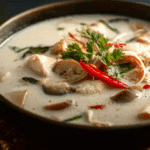
Coconut Galangal Chicken Soup
- Prep Time: 10 minutes
- Cook Time: 25 minutes
- Total Time: 35 minutes
- Yield: 4 servings 1x
- Category: Soup
- Method: Stovetop simmering
- Cuisine: Thai
- Diet: Gluten Free
Description
A creamy, aromatic Thai soup made with coconut milk, galangal, lemongrass, and tender chicken, offering a balance of salty, sour, spicy, and sweet flavors in every spoonful.
Ingredients
- 2 cups chicken stock, unsalted, preferably homemade
- 1 ½ cups coconut milk (see note 1)
- ½ teaspoon table salt
- 1 lb chicken thigh, boneless and skinless, cut into 1-inch pieces (see note 2)
- 1 stalk lemongrass, bottom half only, smashed and cut into 2-inch pieces
- 12 thin slices galangal (see note 3)
- 5 makrut lime leaves, twisted to bruise and torn into large chunks
- 1–3 Thai chilies, to taste, smashed or cut into large pieces
- 2 tablespoons fish sauce
- 1 teaspoon finely chopped palm sugar or granulated sugar
- 5.5 oz oyster mushrooms, torn into bite-size pieces
- 2 ½ tablespoons lime juice
- Chopped green onion and/or cilantro, for garnish
- Jasmine rice, for serving, optional
Instructions
- Bring the chicken stock to a gentle boil, then add the salt and chicken thigh pieces. Simmer for about 15 minutes or until the chicken becomes fork-tender.
- Add the coconut milk, lemongrass, galangal, makrut lime leaves, Thai chilies, mushrooms, half of the fish sauce, and sugar. Simmer lightly for 5 minutes to allow the flavors to infuse.
- Taste and add more fish sauce if needed. Turn off the heat, stir in the lime juice, then taste again and adjust for balance.
- Top with chopped green onions and/or cilantro before serving.
- Serve hot with jasmine rice as part of a Thai meal or enjoy it on its own.
Notes
- Note 1: Use full-fat coconut milk for a richer texture. Stir well before measuring to blend the cream and liquid.
- Note 2: Chicken thigh meat stays tender and flavorful; breast meat can be used for a leaner version.
- Note 3: Fresh galangal provides the best aroma, but frozen slices are acceptable substitutes. Avoid using dried galangal as it lacks flavor.
- The herbs (lemongrass, galangal, and lime leaves) are for infusion only and should be removed before serving or clearly mentioned to guests.
Nutrition
- Serving Size: 1 bowl (about 1 ½ cups)
- Calories: 330
- Sugar: 6g
- Sodium: 780mg
- Fat: 25g
- Saturated Fat: 20g
- Unsaturated Fat: 4g
- Trans Fat: 0g
- Carbohydrates: 9g
- Fiber: 1g
- Protein: 20g
- Cholesterol: 65mg
Keywords: Coconut Galangal Chicken Soup, Tom Kha Gai recipe, Thai coconut chicken soup, creamy coconut soup, easy Tom Kha soup recipe

